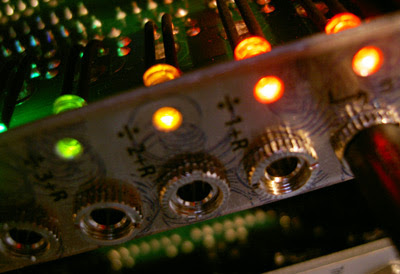
First impressions of the 4MS Rotating Clock Divider.
This colourful module is an update on the classic clock divider design, offering even and un-even divisions of 1 to 64 and a unique rotate function to shift the resulting triggers along its eight outputs.
Here's a run-through featuring four voices. Towards the end, a random CV is applied to the rotate function.
The next example focusses on the rotate function, which is addressed via a CV. While this is more complicated than stepping with a gate, it allows programmed timing-changes with a sequencer or preset controller like Pressure Points.
The RCD outputs triggers, rather than gates. This is useful for percussive material, but has implications for certain logic gating functions. In this example, the main clock is AND-gated by the /4 output, first with a Doepfer A-160, then with the RCD.
The RCD will also function as an audio sub-divider. Here too, the results are different to the A-160 because of the lack of gates.
Sine wave source mixed with 'divided' signal. Choices joystick used to first rotate and then also change pitch.
The following example uses the RCD as a simple three-voice sequencer. The clock is reset on the first beat of the bar until the 1:25 mark (shortly after the FM index riser). Thereafter, the divisions are allowed to run free until about 1:50 (after the decay of the open high hat is lengthened) when it is snapped back into sync. A joystick was used to provide the rotate CV.
This was a lot of fun, but it did highlight an issue common to both the RCD and A-160: neither play 'on the one'. This is apparent when the drums are faded in (0:30). The cymbal denotes the down-beat, the RCD is playing off-beat. This can be 'corrected' on the A-160 with a logic inverter but, as the RCD outputs triggers, this is not possible. Another thing that became clear was the need for some planning with a programmer to set appropriate divisions, rather than wiggling a joystick!
The RCD got me thinking and working in a way I hadn't previously and I wanted to see whether the A-160/ 1 could compete. In this recording I mimicked the previous patch with the Doepfer clocking modules and fed four different reset triggers via an A-151 sequential switch which I stepped with a manual gate.
This resulted in less drastic changes than rotating divisions, but the shifting rhythmical patterns were no less musical or interesting. I also got the impression that the Doepfer divider had a bit more 'funk' than the 4MS, but this might just be down to timing inaccuracies on the part of the A-160.
The 4MS Rotating Clock Divider is mesmerizing, immediate and a lot of fun. Having easy access to un-even divisions was a revelation and the reset possibilities allow for complex rhythmic patterns. I'm not sure I'd want it as the only clock divider in my system, but it could certainly fulfill that role.
To wrap things up, today's Patch of the Day features the RCD and Plan B's M23 ASR.
shufti
Two VCOs, panned left and right receive shifted pitch and trigger information. A Wogglebug provides a random CV to rotate the RCD, modulate Maths' envelope length and transpose the sequence.



2 comments:
Nice run-through and good to hear a comparison with the A-160! To further explain the gate/trigger issue: the width of each pulse coming out of the RCD will be equal to the width of the input clock (it's not scaled by the divisions). So they function best as triggers, but some short gates can be achieved at the smaller divider outputs by using a very wide pulse for a clock input (e.g. an inverted trigger pulse)
Thanks for checking out the demo and the trigger information, Dann. I don't see it as an issue, merely a difference. Depending on the application, both methods of processing the clock (A-160 gates & RCD triggers) have their benefits and drawbacks. Looking forward to the clock multiplier! Cheers, Navs.
Post a Comment